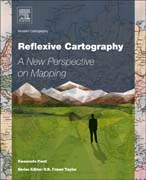
Reflexive Cartography addresses the adaptation of cartography, including its digital forms (GIS, WebGIS, PPGIS), to the changing needs of society, and outlines the experimental context aimed at mapping a topological space. Using rigorous scientific analysis based on statement consistency, relevance of the proposals, and model accessibility, it charts the transition from topographical maps created by state agencies to open mapping produced by citizens. Adopting semiotic theory to uncover the complex communicative mechanisms of maps and to investigate their ability to produce their own messages and new perspectives, Reflexive Cartography outlines a shift in our way of conceptualizing maps: from a plastic metaphor of reality, as they are generally considered, to solid tools that play the role of agents, assisting citizens as they think and plan their own living place and make sense of the current world. Applies a range of technologies to theoretical perspectives on mapping to innovatively map the world's geographic diversityFeatures a multi-disciplinary perspective that weaves together geography, the geosciences, and the social sciences through territorial representationAuthored and edited by two of the world's foremost cartographic experts who combine more than 60 years of experience in research and in the classroomPresents more than 60 figures to underscore key concepts INDICE: Contents PART ONE Chapter 1. Cartographic interpretation between continuity and renewal: on the trail of chora 1.1. Society and cartography 1.2. The role of theory in critical cartography? 1.3. The objective perspective 1.4. The deconstructionist perspective 1.5. The hermeneutic perspective 1.6. From topos to chora Chapter 2. The triumph of topos in colonial cartography: topographic metrics 2.1. Understanding and describing Africa 2.2. In search of topos: topographic maps 2.3. The strengthening of topos: taxonomy and thematism 2.4. Iconization of topos: Maps between science and popularization 2.5. Semiosis and topographic metrics Chapter 3. Landscape as a cartographic icon 3.1. Connections, hybridizations 3.2. Landscape and geographic maps 3.3. Perspective and semiotics of vision 3.4. Iconic resonances 3.5. Sketching ideas, conveying concepts PART TWO Chapter 4. Technology in action: participatory cartographic systems 4.1. Metamorphosis of the cartographic world 4.2. The SIGAP strategy in RBT W (West Africa) 4.3. From paper to screen: PPGIS and online maps 4.4. Online Cartography: interactivity and tentative semiotic implications Chapter 5. Chorographic horizon: landscape cartography 5.1. Semiosis and chorographic metrics 5.2. Gobnangou: an all-encircling cliff? 5.3. Social identity and environmental perspective: the Arly UPC 5.4. Participatory landscape cartography 5.5. The landscape dimension of icons Chapter 6. Coming full circle: towards a Chorography 6.1. Cartography representation of spatiality through the centuries 6.2. Cartographic spatialization of globalization 6.3. From representation to chorographic spatiality Compass / navigation Index of Authors Table of Figures
- ISBN: 978-0-12-803509-2
- Editorial: Elsevier
- Encuadernacion: Rústica
- Páginas: 300
- Fecha Publicación: 01/08/2015
- Nº Volúmenes: 1
- Idioma: Inglés
